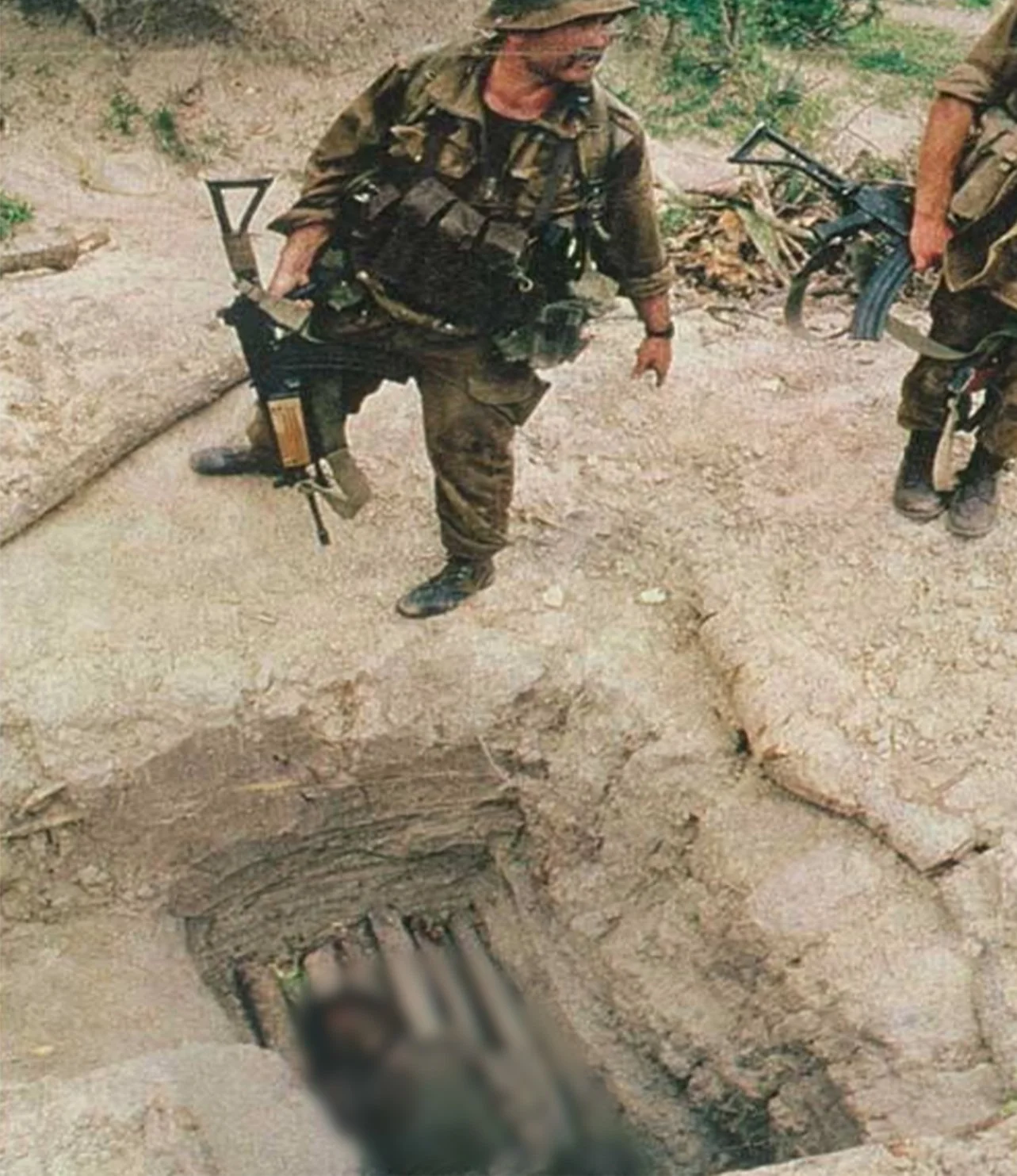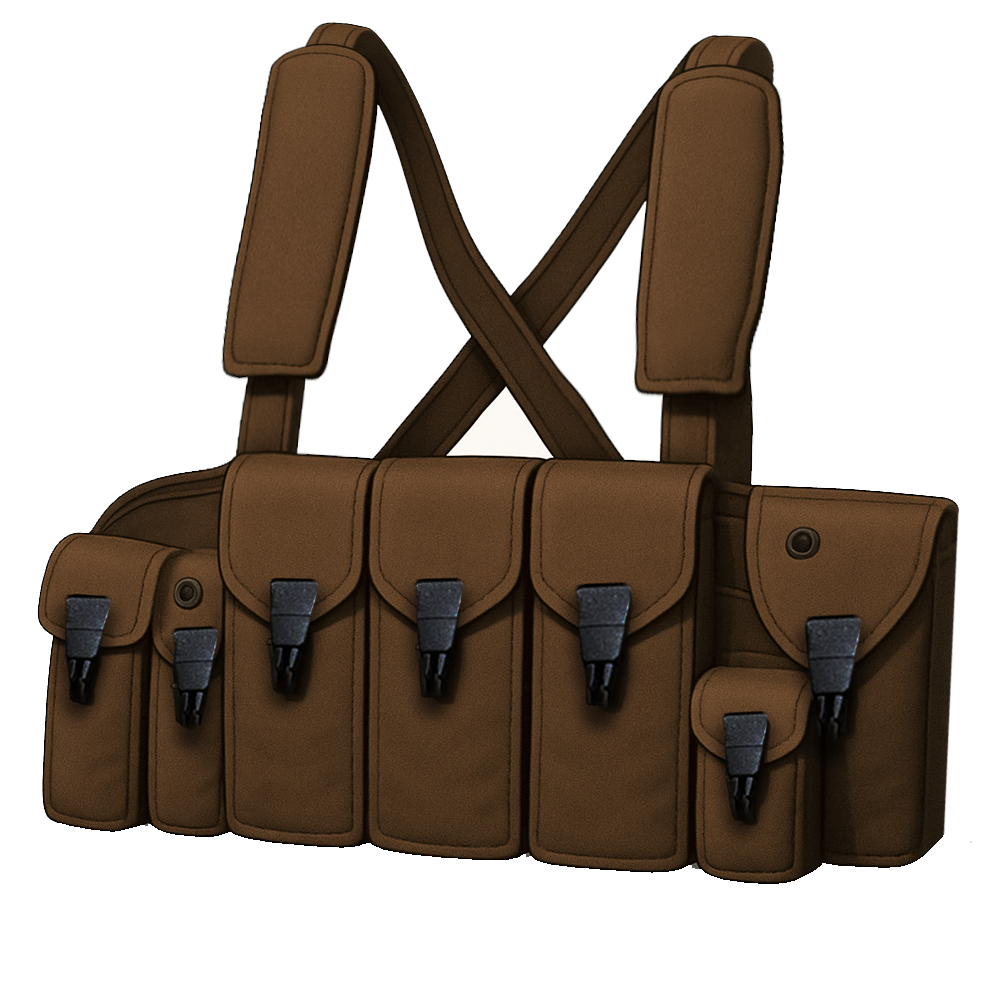PHOTO: Peter, standing along a captured SWAPO trench, as he and the Paras consolidate around enemy position. A full front profile of Peter’s tactical loadout is visible. A deceased SWAPO fighter is seen in the trench, and blurred due to the graphic nature of the original photo. Photo taken by Al J. Venter.
PHOTO: Representation of the unique “PARAFOX” chest rig, an extremely rare item utilized by members of 44 Parachute Battalion’s Pathfinder Platoon. This was Peter’s favoured load-bearing equipment during his time in the South African Defence Force, and a cumulation of decades of experience on the “sharp-end” around the world. Photo rendered by webmaster.
PHOTO: Peter checks a SWAPO prisoner, as another Parabat covers him - standard operating procedure for handling detainees. Given the “intimate” nature of such a search, Peter’s field hat is removed. Visible very clearly are the “scales” on the shoulders of his “Slangvel” jacket. Visible is Peter’s tattoo, original a skull with a paratrooper beret, but covered up with a flower design after he joined the Special Air Service. Additionally, on his right arm, though not visible, was his blood type tattooed “A POS”. Photo taken by Al J. Venter.
The following is a kit breakdown of Peter McAleese’ gear, while participating in Operation Vastrap on 15 January 1981. The information is taken from a verbatim account given by Peter in 2023 to the webmaster. It should give the reader and idea on his operational mindset, while operating in a high-octane combat situation.
The mission was a raid on a SWAPO (South West Africa People’s Organization) base at Cuamato, Angola, and the South African Parabats had prepared for several days, amassing forces near the Angolan border. . Peter led a one of two sections, the other commanded by the late Sergeant Major Dennis Croukamp, members of the 44 Parachute Brigade. They were hand selected to accompany “C” Company, 1st Parachute Battalion, SADF and provide their expertise as the elite “Pathfinders”.
Primary Weapon: South African Vektor R4 Assault Rifle w/ 40 round “extendo” magazine, standard R4 service rifle sling, and paracord wound around the skeleton stock. Paracord wound around the stock was a long standing habit of Peter, for the direct purpose of assisting in escape-and-evasion. As per Peter’s account, the R4 or “South African Galil” was prone to double feeds. At one point, Peter’s R4 jammed while clearing a trench at Cuamoto with white phosophorus grenades. He was forced to strike a burning SWAPO fighter with the buttstock of the R4 until another Para dispatched the enemy combatant. He attributes the likely reason for the weapon stoppage due to overheating, both due to the hot weather and “heavy use” during the trench clearing phase of the operation.
Secondary Weapon: Browning Hi-Power 9mm Pistol, tucked into the unique holster pouch of the Parafox Chest Rig, on Peter’s left hand side. As per Peter’s account, the Hi-Power saved his life the following morning as he cleared additional bunkers at the SWAPO base camp:
“The K-Cars had really shot the guts out of SWAPO but we still went through our drills, attacking with covering fire, firing, doubling forward, firing again, grenading the trenches and underground bunkers, firing into them to make sure the enemy were dead, consolidating and moving on. In the darkness of one old bunker, I was nearly caught out by the enemy’s old trick of pretending to be dead. As I moved cautiously inside, shining my torch about, out of the corner of my eye, I spotted the glistening skin of a black SWAPO guerilla behind me. There was no time to turn my body. In an instant, I swung my pistol up and over my shoulder and shot him three times.” (“No Mean Soldier” pg. 164)
Hat: Standard South African Defence Force Nutria Brown Field Cap or “Boonie”. The extremely wide brim of the hat was a necessity under the intense African sun, but proved to be a nuisance at times. In some photographic evidence from the day, Peter has taken off the hat during some of the more “close quarters” moments. This includes any included any of the air assault aspects of the raid (as the helicopter prop blast would blow any headdress off) and the inspection of prisoners of war. Peter generally preferred wearing a shorter-brimed Pathfinder style hat with a neck brim in garrison, though this was a rather rare item only given out to elite paratroopers.
Jacket: 1st Pattern South African Defence Force Parachutist Smock, or “Slangvel” - nicknamed so after the distinctive “scale” like features on the shoulder-elbow areas of the jacket. As per Peter’s testimony, it was the earlier 1st Pattern style which featured a softer edge on the pocket flap. It was an outstanding garment for the raid, as it was rugged and utilitarian. Peter rolled up the jacket sleeves during the operation due to the hot weather of the daytime.
Undershirt: South African issue brown t-shirt, U-neck style and slightly oversized. As it was a 100% cotton shirt with a seamless tubular construction, it had stretched considerable after extended usage, making it a comfortable, if perhaps baggy garment.
Chest Rig: Private purchase “PARAFOX” manufactured Chest Rig - patterned similar to the later South African Defence Force Pattern 83 Chest Rig, it featured a full Nylon construction and a unique left-side holster pouch for quick access to a side arm. Apparently, due to the close quarters nature of the fighting, and the small trenches and fighting positions, the location of the pistol holster pouch came in handy, however unorthodox by modern standards. It additional had room for 6 magazines of 5.56mm ammunition for the R4 rifle, and 3 auxillary pouches for grenades and medical equipment.
Webbing Harness: USGI LC1 Nylon Webbing Suspender and Belt, with American ALICE M67/LC1 pouches. Peter suspected that it was smuggled in enmass by American volunteers in the 44 Parabats Pathfinder Platoon, as there was no official American military support for South Africa at the time. He was quite impressed with the “fishbone” buckles, as he described it. These made it far easier to access for quick magazine change, than the traditional British style buckle-closures of the time period. Not visible in most photos are the white phosphorus and smoke grenades, which would have been hung onto the webbing via the convenient loops on the American pattern suspenders.
Auxiliary Pouches: As per Peter’s recollection, there was anywhere from 1 to 2 auxillary pouches of the US M1967 tall or LC1 variety, constructed of nylon with the “fishbone” buckle closure system that Peter preferred. These were used to carry additional ammunition and other essentials. One such pouch is clearly visible on Peter’s beltline in several period photos, fully loaded with additional magazines.
Hydration: USGI 1Qt Plastic Canteens w/ Flat Caps x 2, tucked into USGI LC1 canteen pouches. Peter confirmed the visual horizontal seams and water purification tablet pouches, distinctive to the later LC1 pattern pouches. Like the webbing harness, these too were likely smuggled in en-masse by American volunteers in the unit. With the massive South African air power behind them during the raid and regular resupply, little additional sustainment kit beyond water would have been carried.
Boots: USGI 3rd Pattern Jungle Boots w/ Recce modification. As per Peter’s recollection, the boots originally were procured with a thick Panama sole, which Peter had unit level cobblers file down into a completely flat sole. While it made it significantly harder to have any traction on hard ground, it worked to conceal his footsteps from leaving obvious spoor signs. Additionally, with his escape-and-evasion mindset, it was intended to also be an immediate tool for counter-tracking if compromised in any way.
Wristwatch: 1980s Seiko Sportsmatic - Peter did not recall the exact variant, but did recall one very important detail - “it was very cheap”. It was sometimes covered with a makeshift piece of Rhodesian camouflage material on certain Recce missions where the shine of the watch crystal and case could be a hinderance. On the Cuamato raid, the Parabats went in gun blazing, negating the need to “cam-up” the watch.
E&E Kit: In addition to his standard kit, was the always present escape-and-evasion (E&E) kit that Peter always carried. This consisted of a button compass sewn into Peter’s Slangvel jacket, and a small tin box containing a wire saw, firestarters, and strands of paracord.



